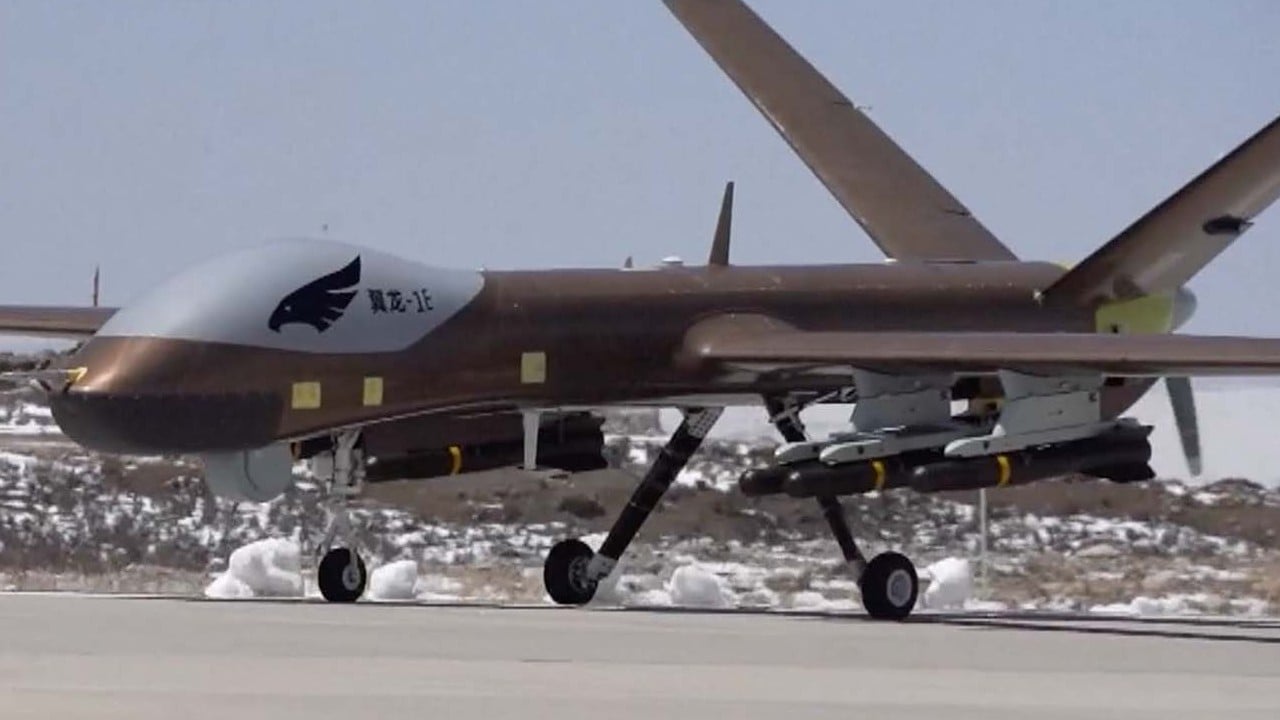
AI pilot beats human in landmark real-life dogfight, Chinese military researchers report
- ‘AI will soon be the king of the sky,’ scientists say after artificial intelligence machine shows superior performance in cutting-edge close-range combat
- Next-gen AI pilot under development could learn during a real flight and improve its performance with little or no ground support, Chinese developer says
It was published a month after the United States military said an AI pilot had recently conducted numerous test missions, including combat drills, on a real F-16 fighter.
The Chinese dogfight involved two small unmanned fixed-wing aircraft – one with an AI pilot on board and the other controlled remotely by a human pilot on the ground.
When the fight started, the human made the first move to gain the upper hand.
The AI, apparently predicting his intention, outmanoeuvred the opponent, made a counter move and stuck close behind its opponent.
The human-controlled aircraft dived to lure the machine to crash to the ground. The AI then moved to an ambush position and waited for the opponent to pull up.
The human pilot tried other tactics such as “rolling scissors” – a sudden slow-down and change of course – hoping the AI would overshoot in the chase.
The simulation was called off by the team after about 90 seconds because the human controller could not evade its AI opponent.
US, China, other nations urge ‘responsible’ use of military AI
“The era of air combat in which artificial intelligence will be the king is already on the horizon,” said the project team in a paper published on February 27 in the peer-reviewed Chinese journal Acta Aeronautica et Astronautica Sinica.
The project was led by professor Huang Juntao of the China Aerodynamics Research and Development Centre, a People’s Liberation Army research institute in the southwestern province of Sichuan that develops and tests futuristic weapon technologies.
“Aircraft with autonomous decision-making capabilities can completely outperform humans in terms of reaction speed,” Huang and his colleagues said in the paper.
When making sharp turns, the machine also did not have to consider human worries, such as blood being drained from the brain by excessive gravitational pull or concerns about being harmed, according to the researchers.
“With superior calculation ability it can more accurately predict the development of the battle to gain the initiative in the confrontation,” Huang’s team said.
“Due to the advancement of stealth and electronic countermeasure technology, 25-40 per cent of air combat will be carried out at close range in the future. Research on close-range combat has significant value in practice,” they added.
Research on AI pilot technology started about 60 years ago in the US, but China has caught up quickly, according to the Chinese team.
In 2020, a deep-learning AI system developed by Maryland-based company Heron Systems defeated some of the most experienced F-16 pilots in all five dogfights on a ground-based simulator.
AI plays professional war games like a human, Chinese developers say
The US military also said last month it had put an AI pilot on a real F-16 fighter jet and conducted numerous test missions, including close-range combat, in December.
A human pilot on the modified F-16 oversaw the AI operation, and the “enemies” in these tests were phantom targets created by computers.
Huang’s team did not specify when the test flight took place, but it was before October when the paper was submitted.
Taking AI to the sky is much more difficult than running it on the ground, according to Huang’s team.
Limited computing resources on a plane can severely undermine the AI pilot’s performance, they said.
The real environment in the open world is more complex and unpredictable than those created by mathematical models in a ground simulator and engineers must seriously consider the cost and dangers of a crash.
“The problem of aircraft air combat confrontation is very complex with high dynamics, strong real-time characteristics and a larger solution space,” Huang’s team said. “This poses a huge challenge to the real-life realisation of intelligent decision-making.”
They said there were hardly any reports on bringing the technology from theory to practice.
The Chinese team said it built the AI dogfight pilot with the intention of making it easy for the military to use. The AI’s decision-making process, for instance, was not related to the hardware of a specific plane. This means the AI pilot can operate on almost any fighter jet in the PLA hangar.
The team put an Nvidia Jetson TX2 module in the plane as the AI brain.
China’s ChatGPT ambitions could hinge on AI GPU chips under US sanctions
Although the US government has banned the California-based company from selling its most powerful AI chips to Chinese users, the Jetson series made in China was not on the list.
The Nvidia chip enabled the AI pilot to make 1,000 decisions every second based on data collected by sensors on board the aircraft or from the ground.
The dogfight “proved the engineering feasibility of AI piloting technology” but some challenges remained, according to Huang’s team.
For instance, the AI still needed to be tested in simulated training on a large ground-based computer. Huang’s team said the next-generation AI pilot under development could learn during a real flight and improve its performance with little or no ground support.


